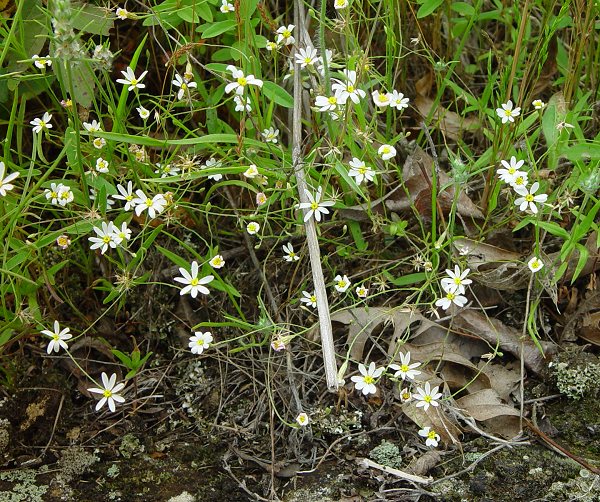Chaetopappa asteroides (Nutt.) DC.
Arkansas Leastdaisy

Native
CC = 10
CW = 5
MOC = 4
© DETenaglia
Chaetopappa asteroides (Nutt.) DC.Arkansas Leastdaisy | |
 |
Native CC = 10 CW = 5 MOC = 4 |
© DETenaglia |
|
Family - Asteraceae/Astereae Habit - Slender, taprooted annual forb.
Stems - Ascending to erect, to 30 cm, sometimes multiple, sometimes with spreading to ascending branches, sparsely to moderately pubescent with appressed to loosely ascending, white hairs, these sometimes broadened at the base.
Leaves - Basal leaves sometimes withered by flowering time, 0.5-2.5 cm long, 0.1-0.5 cm wide, the blade oblanceolate to obovate or spatulate, rounded or less commonly bluntly pointed at the tip, long-tapered to the sometimes short-petiolate base, entire, sparsely to moderately hairy. Stem leaves often somewhat reduced toward the tip of the stem, 0.3-1.5 cm long, linear to narrowly oblanceolate, rounded to bluntly or sharply pointed at the tip, more or less tapered to a slightly expanded but not clasping base, entire, sparsely to moderately hairy.
Inflorescence - Inflorescences sometimes appearing as more or less flat-topped panicles after the leaves wither, consisting of solitary heads at the stem tips, these short to relatively long, usually with few to several minute, linear bracts.
Heads - Radiate. Involucre 2.5-4.0 mm long, narrowly obconical. Involucral bracts in 2-4 unequal, overlapping series, narrowly lanceolate to narrowly oblong-elliptic, the tip ascending, with a relatively broad, green central stripe and narrow to broad, thin, pale (often somewhat transparent) margins, glabrous or sparsely to moderately hairy, at least the inner series finely fringed along the margins toward the tip. Receptacle flat or slightly convex.
Ray flowers - 5-13 per head, pistillate, the corolla 3-5 mm long, white, sometimes pinkish- or purplish-tinged toward the tip, usually turning purple to purplish blue with age, not persistent at fruiting. Disk flowers - 6-25 per head, perfect, the corolla 2-3 mm long, yellow, not persistent at fruiting. Pappus of the ray and disc florets similar (or that of the ray florets occasionally with the awns shorter or lacking), a low crown of usually 5 shorter, white to nearly transparent scales 0.1-0.8 mm long that alternate with an equal number of longer, straw-colored to light brown awns 1-3 mm long.
Fruits - Achenes 1.5-2.0 mm long, wedge-shaped to slightly obovoid, 5-angled, the angles occasionally slightly ribbed, the surface smooth, usually moderately pubescent with minute, appressed hairs, brown to dark brown. Flowering - April - August. Habitat - Glades, upland prairies, savannas, usually on sandstone or chert. Origin - Native to the U.S. Lookalikes - Distantly, Minuartia patula. Other info. - This tiny and inconspicuous species has been found in only four Missouri counties, all in the southwest part of the state. Its U.S. range is almost entirely within six states, with Missouri at the northeast end. It is easily overlooked in the field because of its small size, but is easily identified as nothing else in its family resembles it. The thin, wiry stems and small leaves, and the flowering heads which resemble tiny daisies, are good characters to look for. Photographs taken at Taberville Prairie, MO., 6-7-03 (DETenaglia); also at Blue River fishing and hunting reserve, Johnston County, OK, 5-25-2023 (SRTurner). |